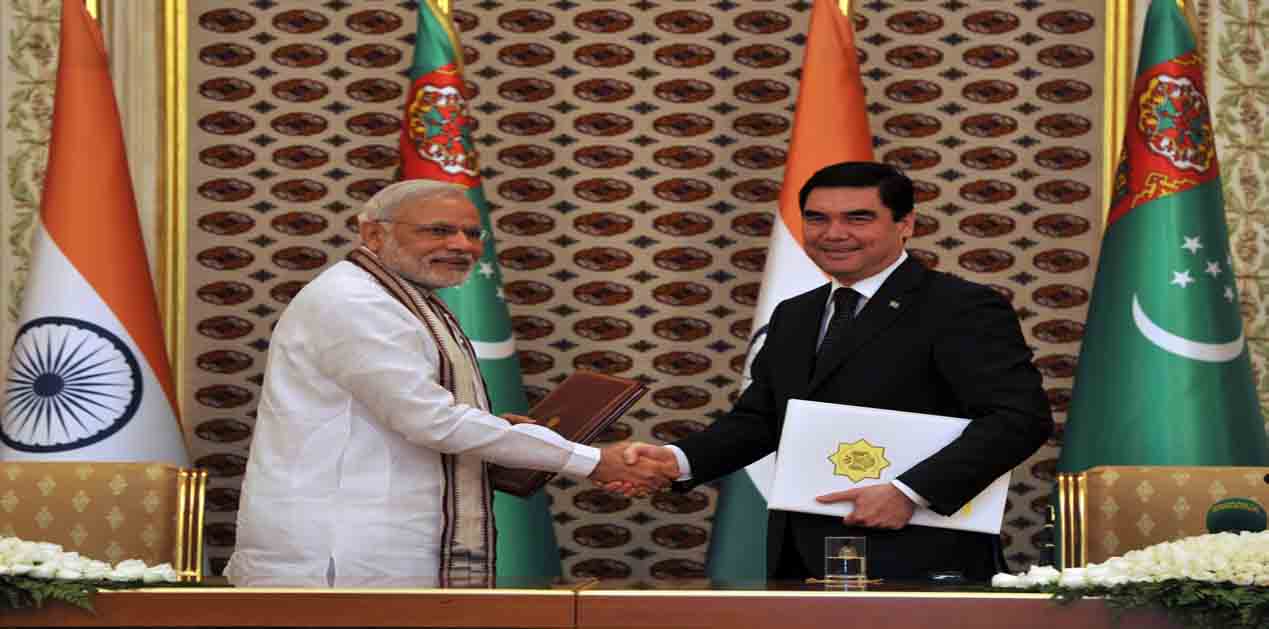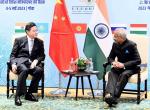Background
India has recently joined the Ashgabat Agreement, which envisages creation of an International Transport and Transit Corridor connecting Central Asia with the Persian Gulf. This corridor is set to facilitate connectivity, trade and transportation of goods between the Central Asian Republics (CARs) and the Gulf countries. With accession to the Agreement, India has taken a step forward in its efforts in enhancing connectivity with Eurasia.
Central Asia is a landlocked region, and all the five CARs have to pass through at least one state for access to the open seas. This region had played an extremely important role in the ancient trade and commerce, as most of the land routes passed through this land. However, with the advent of marine trade, CARs started to lag behind. During the Soviet years, and even after independence of the CARs in 1991, most of its trade took place through the territories of its neighbors like Russia and China, which was lengthy, cumbersome and costly.
It was gradually realized by the CARs that Iran and the Persian Gulf can play a significant role in facilitating access to the open seas. Origin of the idea of transport corridor between Central Asia and the Gulf can be traced to the bilateral meeting between the then President of Uzbekistan Islam Karimov and his Turkmen counterpart Gurbanguli Berdimuhamedov in October 2010. Consequently, representatives of Uzbekistan, Turkmenistan, Iran and Oman met in Tehran in November 2010 to set up a Working Group to study development of such corridor.

Ashgabat Agreement
An agreement on establishing a new international transport and transit corridor was signed between Uzbekistan, Turkmenistan, Iran, Oman and Qatar on 25 April, 2011, at Ashgabat, the capital of Turkmenistan. This agreement, popularly known as the ‘Ashgabat Agreement’ formed the basis for developing the shortest trade route between the CARs and Iranian and Omani ports. The Memorandum of Understanding (MoU) on legal, procedural, infrastructure aspects of the agreement was signed on 06 August 2014 in Muscat.
While Qatar withdrew from the agreement in 2013, Kazakhstan applied for membership in the same year. Its membership was approved during the Coordination Council Meeting in Tehran in 2015. The inclusion of Kazakhstan increased the significance of the agreement, as it is the largest economy of the region. Prime Minister Nawaz Sharif also announced Pakistan’s bid to join the Agreement. In the Global Sustainable Transport Summit held in Ashgabat in November 2016, he appealed to the member-states for approving Pakistan’s membership1. However, it has been unable to gather consent of all four members.
India’s bid to become a member of Ashgabat Agreement received a boost during Prime Minister Modi’s visit to all five CARs in July 2015. Union Cabinet gave its approval for India to accede to the Ashgabat Agreement on 23 March 2016. An official statement from the Cabinet Meeting stated, “Accession to the agreement would enable India to utilise this existing transport and transit corridor to facilitate trade and commercial interaction with the Eurasian region. Further, this would synchronize with our efforts to implement the International North South Transport Corridor (INSTC) for enhanced connectivity” 2. Subsequently, India deposited the Instrument of Accession in April 2016. After receiving consent from all four founding members, India's accession to the Ashgabat Agreement entered into force on 3 February 20183.
Significance of Ashgabat Agreement for India
As mentioned before, Ashgabat Agreement is set to create a trade and transport corridor between the CARs and the Persian Gulf. The corridor will be multi-modal, and shall consist of road, rail and sea transport. It shall also include easing of trade barriers and simple procedures for movement of goods between signatory states. The land transport component of the agreement includes rail links running through Kazakhstan, Uzbekistan, Turkmenistan and Iran. Iran-Turkmenistan-Kazakhstan (ITK) railway line, which became operational in December 2014 is an important leg of this corridor. Besides, it will create a link with Omani ports of Salalah, Duqm and Sohar, and Iranian ports of Bandar Abbas, Jask and Chabahar. The existing transport and connectivity links in the region will be useful for enhancing India’s trade.
CARs are part of India’s extended neighborhood, with whom we have developed cultural, commercial and civilisational links for thousands of years. However, in the present geo-political scenario, India does not have a direct land link with the CARs. This has hampered our trade with these countries. India’s share in the global imports of CARs is miniscule at 0.54 percent. On the other hand, CARs figure marginally in India’s trade basket. In April-December 2017, India’s export to five CARs was 260 million USD, accounting for 0.12 percent share in India’s total export. During the same period, India’s import from the CARs was 961 million USD, making 0.28 percent share in India’s total imports. Out of this, 787 million USD import was from Kazakhstan alone4, making the share of other four CARs miniscule. Population of the CARs is about 70 million, out of which 32 million live in Uzbekistan alone. Thus, these countries are important markets for India. With enhancement of connectivity, India’s trade can expand in qualitative as well as quantitative terms.
CARs have potential to provide a land bridge between Europe and Asia and between various regions of Asia. Strategic location of these countries can also facilitate India’s land connectivity with Eurasian region at large. The Commonwealth of Independent States (CIS) region had a share of 0.91 percent in India’s exports and 1.86 percent in its imports during 2015-16. Russia continues to be India's most important trading partner in the region accounting for about 65 percent of India’s trade with CIS5. India has established intergovernmental commissions and joint working groups with CIS countries of Russia, Ukraine, Azerbaijan, Kazakhstan, Uzbekistan, Kyrgyzstan and Tajikistan; and has pledged to expand its economic footprint in this region.
India, along with Russia and Iran, has signed an agreement on creating the International North-South Transport Corridor (INSTC), which also has Azerbaijan, Armenia, Belarus, Kazakhstan, Kyrgyzstan, Tajikistan and Oman as its members. India has also ratified the ‘Transports Internationaux Routiers’ (TIR) Convention, which facilitates trans-border movement of goods. Uzbekistan and Turkmenistan are also parties to the TIR convention, although they have not yet joined the INSTC. Joining the Ashgabat Agreement shall surely feel in this missing link, and thus facilitate seamless link with Eurasia. Accession to the Agreement shall also diversify India’s connectivity options with Central Asia.
India considers Iran to be our gateway to Eurasia, and thus, important link in the INSTC. India has recently sent its first consignment to Afghanistan through the Chabahar Port. It has also planned to construct a railway between Chabahar to Zahedan. New Delhi is preparing to host the Iranian President this month. Prime Minister Modi is about to visit the Gulf state of Oman, during his visit to West Asia on 9-12 February. At this backdrop, joining the Ashgabat Agreement is definitely a step forward in India’s march into Eurasia.
End Notes
1. Prime Minister Nawaz Sharif’s Statement at the Global Sustainable Transport Conference at Ashgabat, on 26 November 2016, Accessed 07 February 2018, URL: http://webtv.un.org/watch/h.-e.-muhammad-nawaz-sharif-pakistan-global-sustainable-transport-conference-ashgabat-2016-1st-plenary-session/5225059941001.
2. Press Information Bureau, Government of India- Cabinet, 23 March 2016, Accessed 07 February 2018, URL: http://pib.nic.in/newsite/PrintRelease.aspx?relid=138309.
3. MEA Press Release, 01 February 2018, Accessed 04 February 2018, URL: http://www.mea.gov.in/press-releases.htm?dtl/29406/India_Joins_the_Ashgabat_Agreement.
4. Ministry of Commerce Statistics, System on Foreign Trade Performance Analysis, Accessed 06 February 2018, URL: http://commerce.nic.in/ftpa/rgncnt.asp.
5. Ministry of Commerce, Government of India, Annual Report 2016-17, Accessed 06 February 2018, URL: http://commerce.gov.in/writereaddata/uploadedfile/MOC_636281140249481285_annual_report_16_17_eng.pdf.
(Views expressed are of the author and do not necessarily reflect the views of the VIF)
Image Source: http://www.dentisty.org/prime-minister-shri-narendra-modi-on-arrival-in-turkmenistan-p/18973_html_12ccb595.jpg











Post new comment